Impact of the Vietnam War on International Relations
VerifiedAdded on 2023/06/12
|8
|2323
|106
AI Summary
This article discusses the impact of the Vietnam War on international relations, including the political forces involved, war crimes committed, displacement and devastation of Vietnamese citizens, and the unification of North and South Vietnam.
Contribute Materials
Your contribution can guide someone’s learning journey. Share your
documents today.
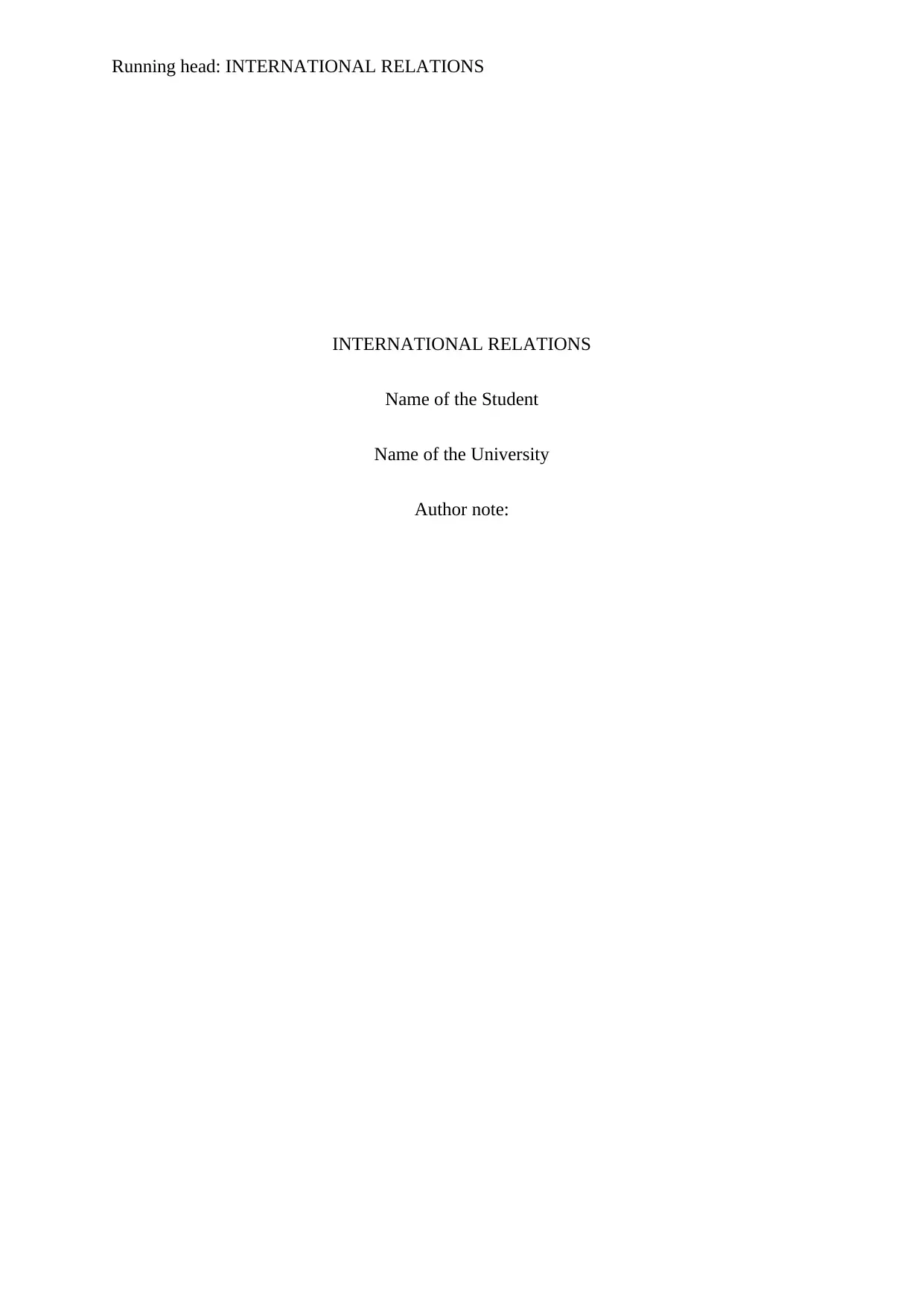
Running head: INTERNATIONAL RELATIONS
INTERNATIONAL RELATIONS
Name of the Student
Name of the University
Author note:
INTERNATIONAL RELATIONS
Name of the Student
Name of the University
Author note:
Secure Best Marks with AI Grader
Need help grading? Try our AI Grader for instant feedback on your assignments.
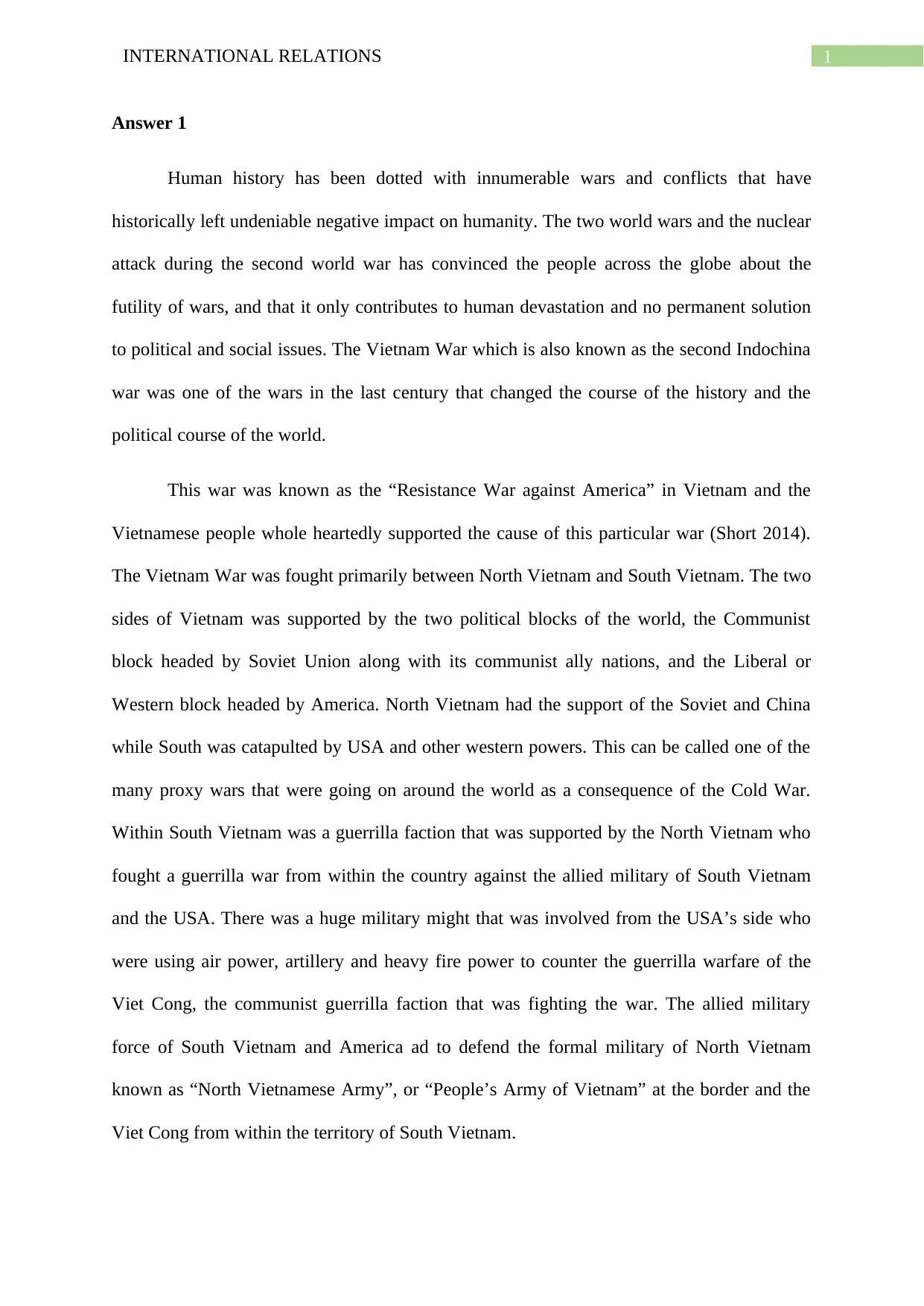
1INTERNATIONAL RELATIONS
Answer 1
Human history has been dotted with innumerable wars and conflicts that have
historically left undeniable negative impact on humanity. The two world wars and the nuclear
attack during the second world war has convinced the people across the globe about the
futility of wars, and that it only contributes to human devastation and no permanent solution
to political and social issues. The Vietnam War which is also known as the second Indochina
war was one of the wars in the last century that changed the course of the history and the
political course of the world.
This war was known as the “Resistance War against America” in Vietnam and the
Vietnamese people whole heartedly supported the cause of this particular war (Short 2014).
The Vietnam War was fought primarily between North Vietnam and South Vietnam. The two
sides of Vietnam was supported by the two political blocks of the world, the Communist
block headed by Soviet Union along with its communist ally nations, and the Liberal or
Western block headed by America. North Vietnam had the support of the Soviet and China
while South was catapulted by USA and other western powers. This can be called one of the
many proxy wars that were going on around the world as a consequence of the Cold War.
Within South Vietnam was a guerrilla faction that was supported by the North Vietnam who
fought a guerrilla war from within the country against the allied military of South Vietnam
and the USA. There was a huge military might that was involved from the USA’s side who
were using air power, artillery and heavy fire power to counter the guerrilla warfare of the
Viet Cong, the communist guerrilla faction that was fighting the war. The allied military
force of South Vietnam and America ad to defend the formal military of North Vietnam
known as “North Vietnamese Army”, or “People’s Army of Vietnam” at the border and the
Viet Cong from within the territory of South Vietnam.
Answer 1
Human history has been dotted with innumerable wars and conflicts that have
historically left undeniable negative impact on humanity. The two world wars and the nuclear
attack during the second world war has convinced the people across the globe about the
futility of wars, and that it only contributes to human devastation and no permanent solution
to political and social issues. The Vietnam War which is also known as the second Indochina
war was one of the wars in the last century that changed the course of the history and the
political course of the world.
This war was known as the “Resistance War against America” in Vietnam and the
Vietnamese people whole heartedly supported the cause of this particular war (Short 2014).
The Vietnam War was fought primarily between North Vietnam and South Vietnam. The two
sides of Vietnam was supported by the two political blocks of the world, the Communist
block headed by Soviet Union along with its communist ally nations, and the Liberal or
Western block headed by America. North Vietnam had the support of the Soviet and China
while South was catapulted by USA and other western powers. This can be called one of the
many proxy wars that were going on around the world as a consequence of the Cold War.
Within South Vietnam was a guerrilla faction that was supported by the North Vietnam who
fought a guerrilla war from within the country against the allied military of South Vietnam
and the USA. There was a huge military might that was involved from the USA’s side who
were using air power, artillery and heavy fire power to counter the guerrilla warfare of the
Viet Cong, the communist guerrilla faction that was fighting the war. The allied military
force of South Vietnam and America ad to defend the formal military of North Vietnam
known as “North Vietnamese Army”, or “People’s Army of Vietnam” at the border and the
Viet Cong from within the territory of South Vietnam.
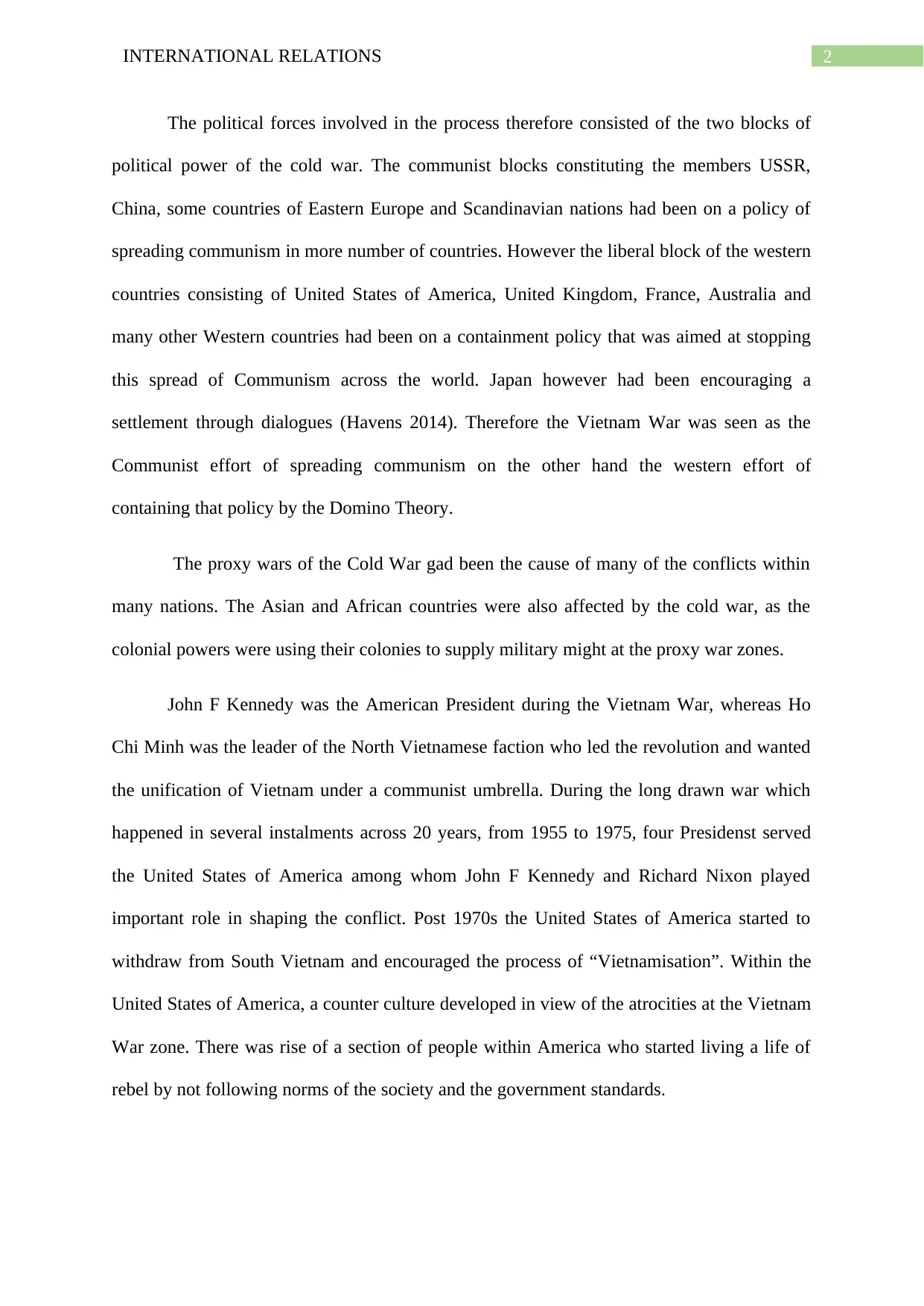
2INTERNATIONAL RELATIONS
The political forces involved in the process therefore consisted of the two blocks of
political power of the cold war. The communist blocks constituting the members USSR,
China, some countries of Eastern Europe and Scandinavian nations had been on a policy of
spreading communism in more number of countries. However the liberal block of the western
countries consisting of United States of America, United Kingdom, France, Australia and
many other Western countries had been on a containment policy that was aimed at stopping
this spread of Communism across the world. Japan however had been encouraging a
settlement through dialogues (Havens 2014). Therefore the Vietnam War was seen as the
Communist effort of spreading communism on the other hand the western effort of
containing that policy by the Domino Theory.
The proxy wars of the Cold War gad been the cause of many of the conflicts within
many nations. The Asian and African countries were also affected by the cold war, as the
colonial powers were using their colonies to supply military might at the proxy war zones.
John F Kennedy was the American President during the Vietnam War, whereas Ho
Chi Minh was the leader of the North Vietnamese faction who led the revolution and wanted
the unification of Vietnam under a communist umbrella. During the long drawn war which
happened in several instalments across 20 years, from 1955 to 1975, four Presidenst served
the United States of America among whom John F Kennedy and Richard Nixon played
important role in shaping the conflict. Post 1970s the United States of America started to
withdraw from South Vietnam and encouraged the process of “Vietnamisation”. Within the
United States of America, a counter culture developed in view of the atrocities at the Vietnam
War zone. There was rise of a section of people within America who started living a life of
rebel by not following norms of the society and the government standards.
The political forces involved in the process therefore consisted of the two blocks of
political power of the cold war. The communist blocks constituting the members USSR,
China, some countries of Eastern Europe and Scandinavian nations had been on a policy of
spreading communism in more number of countries. However the liberal block of the western
countries consisting of United States of America, United Kingdom, France, Australia and
many other Western countries had been on a containment policy that was aimed at stopping
this spread of Communism across the world. Japan however had been encouraging a
settlement through dialogues (Havens 2014). Therefore the Vietnam War was seen as the
Communist effort of spreading communism on the other hand the western effort of
containing that policy by the Domino Theory.
The proxy wars of the Cold War gad been the cause of many of the conflicts within
many nations. The Asian and African countries were also affected by the cold war, as the
colonial powers were using their colonies to supply military might at the proxy war zones.
John F Kennedy was the American President during the Vietnam War, whereas Ho
Chi Minh was the leader of the North Vietnamese faction who led the revolution and wanted
the unification of Vietnam under a communist umbrella. During the long drawn war which
happened in several instalments across 20 years, from 1955 to 1975, four Presidenst served
the United States of America among whom John F Kennedy and Richard Nixon played
important role in shaping the conflict. Post 1970s the United States of America started to
withdraw from South Vietnam and encouraged the process of “Vietnamisation”. Within the
United States of America, a counter culture developed in view of the atrocities at the Vietnam
War zone. There was rise of a section of people within America who started living a life of
rebel by not following norms of the society and the government standards.
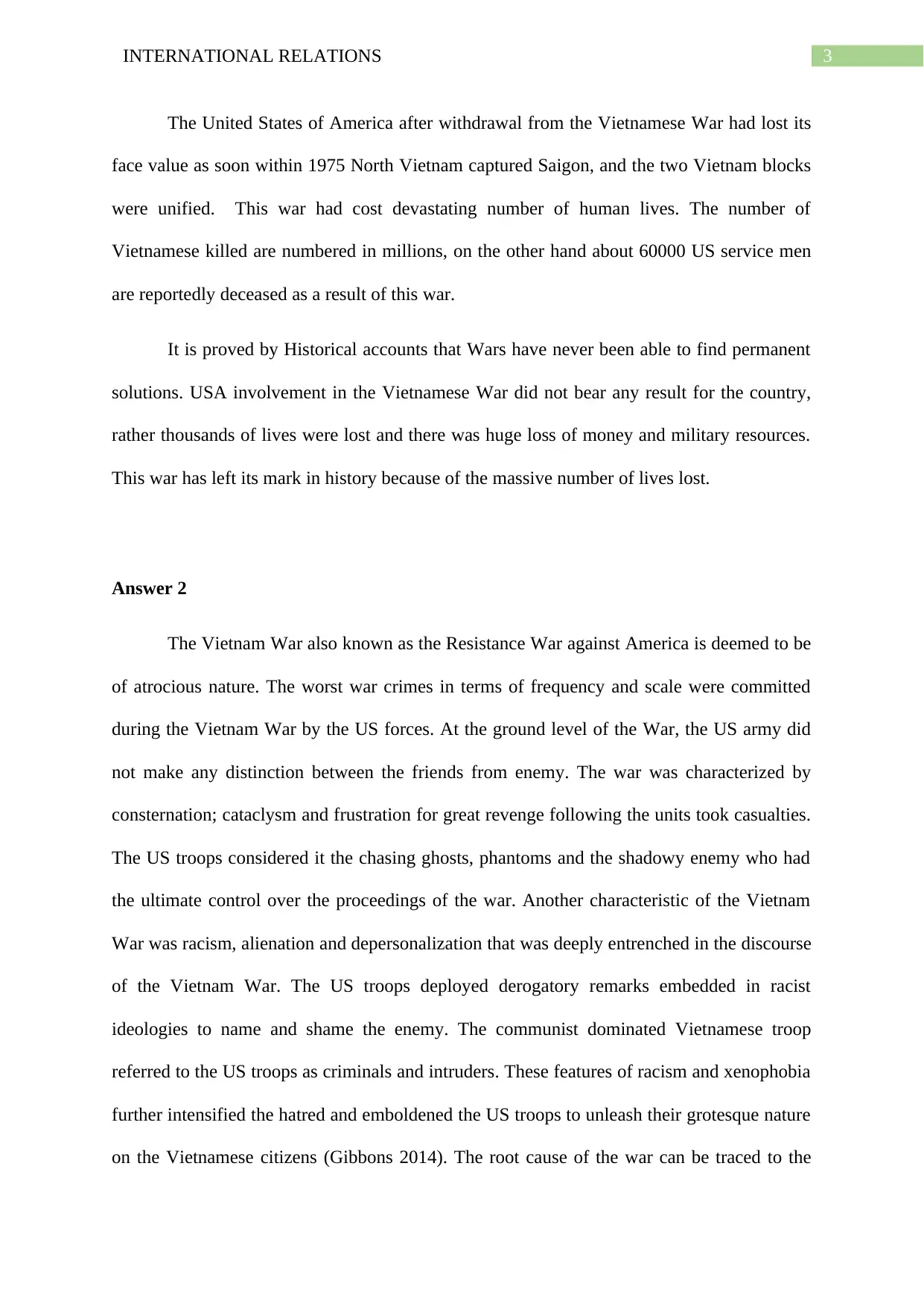
3INTERNATIONAL RELATIONS
The United States of America after withdrawal from the Vietnamese War had lost its
face value as soon within 1975 North Vietnam captured Saigon, and the two Vietnam blocks
were unified. This war had cost devastating number of human lives. The number of
Vietnamese killed are numbered in millions, on the other hand about 60000 US service men
are reportedly deceased as a result of this war.
It is proved by Historical accounts that Wars have never been able to find permanent
solutions. USA involvement in the Vietnamese War did not bear any result for the country,
rather thousands of lives were lost and there was huge loss of money and military resources.
This war has left its mark in history because of the massive number of lives lost.
Answer 2
The Vietnam War also known as the Resistance War against America is deemed to be
of atrocious nature. The worst war crimes in terms of frequency and scale were committed
during the Vietnam War by the US forces. At the ground level of the War, the US army did
not make any distinction between the friends from enemy. The war was characterized by
consternation; cataclysm and frustration for great revenge following the units took casualties.
The US troops considered it the chasing ghosts, phantoms and the shadowy enemy who had
the ultimate control over the proceedings of the war. Another characteristic of the Vietnam
War was racism, alienation and depersonalization that was deeply entrenched in the discourse
of the Vietnam War. The US troops deployed derogatory remarks embedded in racist
ideologies to name and shame the enemy. The communist dominated Vietnamese troop
referred to the US troops as criminals and intruders. These features of racism and xenophobia
further intensified the hatred and emboldened the US troops to unleash their grotesque nature
on the Vietnamese citizens (Gibbons 2014). The root cause of the war can be traced to the
The United States of America after withdrawal from the Vietnamese War had lost its
face value as soon within 1975 North Vietnam captured Saigon, and the two Vietnam blocks
were unified. This war had cost devastating number of human lives. The number of
Vietnamese killed are numbered in millions, on the other hand about 60000 US service men
are reportedly deceased as a result of this war.
It is proved by Historical accounts that Wars have never been able to find permanent
solutions. USA involvement in the Vietnamese War did not bear any result for the country,
rather thousands of lives were lost and there was huge loss of money and military resources.
This war has left its mark in history because of the massive number of lives lost.
Answer 2
The Vietnam War also known as the Resistance War against America is deemed to be
of atrocious nature. The worst war crimes in terms of frequency and scale were committed
during the Vietnam War by the US forces. At the ground level of the War, the US army did
not make any distinction between the friends from enemy. The war was characterized by
consternation; cataclysm and frustration for great revenge following the units took casualties.
The US troops considered it the chasing ghosts, phantoms and the shadowy enemy who had
the ultimate control over the proceedings of the war. Another characteristic of the Vietnam
War was racism, alienation and depersonalization that was deeply entrenched in the discourse
of the Vietnam War. The US troops deployed derogatory remarks embedded in racist
ideologies to name and shame the enemy. The communist dominated Vietnamese troop
referred to the US troops as criminals and intruders. These features of racism and xenophobia
further intensified the hatred and emboldened the US troops to unleash their grotesque nature
on the Vietnamese citizens (Gibbons 2014). The root cause of the war can be traced to the
Secure Best Marks with AI Grader
Need help grading? Try our AI Grader for instant feedback on your assignments.
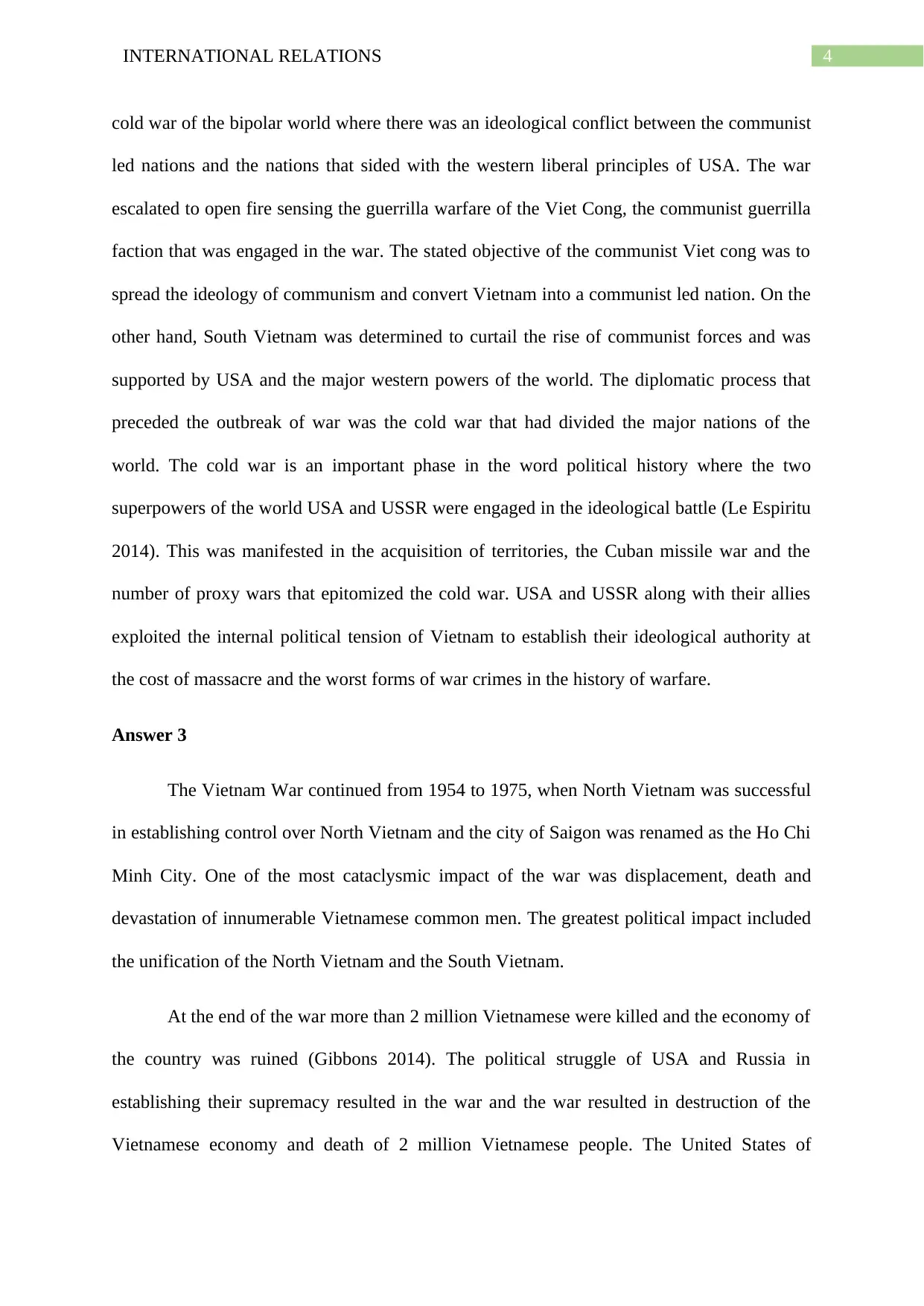
4INTERNATIONAL RELATIONS
cold war of the bipolar world where there was an ideological conflict between the communist
led nations and the nations that sided with the western liberal principles of USA. The war
escalated to open fire sensing the guerrilla warfare of the Viet Cong, the communist guerrilla
faction that was engaged in the war. The stated objective of the communist Viet cong was to
spread the ideology of communism and convert Vietnam into a communist led nation. On the
other hand, South Vietnam was determined to curtail the rise of communist forces and was
supported by USA and the major western powers of the world. The diplomatic process that
preceded the outbreak of war was the cold war that had divided the major nations of the
world. The cold war is an important phase in the word political history where the two
superpowers of the world USA and USSR were engaged in the ideological battle (Le Espiritu
2014). This was manifested in the acquisition of territories, the Cuban missile war and the
number of proxy wars that epitomized the cold war. USA and USSR along with their allies
exploited the internal political tension of Vietnam to establish their ideological authority at
the cost of massacre and the worst forms of war crimes in the history of warfare.
Answer 3
The Vietnam War continued from 1954 to 1975, when North Vietnam was successful
in establishing control over North Vietnam and the city of Saigon was renamed as the Ho Chi
Minh City. One of the most cataclysmic impact of the war was displacement, death and
devastation of innumerable Vietnamese common men. The greatest political impact included
the unification of the North Vietnam and the South Vietnam.
At the end of the war more than 2 million Vietnamese were killed and the economy of
the country was ruined (Gibbons 2014). The political struggle of USA and Russia in
establishing their supremacy resulted in the war and the war resulted in destruction of the
Vietnamese economy and death of 2 million Vietnamese people. The United States of
cold war of the bipolar world where there was an ideological conflict between the communist
led nations and the nations that sided with the western liberal principles of USA. The war
escalated to open fire sensing the guerrilla warfare of the Viet Cong, the communist guerrilla
faction that was engaged in the war. The stated objective of the communist Viet cong was to
spread the ideology of communism and convert Vietnam into a communist led nation. On the
other hand, South Vietnam was determined to curtail the rise of communist forces and was
supported by USA and the major western powers of the world. The diplomatic process that
preceded the outbreak of war was the cold war that had divided the major nations of the
world. The cold war is an important phase in the word political history where the two
superpowers of the world USA and USSR were engaged in the ideological battle (Le Espiritu
2014). This was manifested in the acquisition of territories, the Cuban missile war and the
number of proxy wars that epitomized the cold war. USA and USSR along with their allies
exploited the internal political tension of Vietnam to establish their ideological authority at
the cost of massacre and the worst forms of war crimes in the history of warfare.
Answer 3
The Vietnam War continued from 1954 to 1975, when North Vietnam was successful
in establishing control over North Vietnam and the city of Saigon was renamed as the Ho Chi
Minh City. One of the most cataclysmic impact of the war was displacement, death and
devastation of innumerable Vietnamese common men. The greatest political impact included
the unification of the North Vietnam and the South Vietnam.
At the end of the war more than 2 million Vietnamese were killed and the economy of
the country was ruined (Gibbons 2014). The political struggle of USA and Russia in
establishing their supremacy resulted in the war and the war resulted in destruction of the
Vietnamese economy and death of 2 million Vietnamese people. The United States of
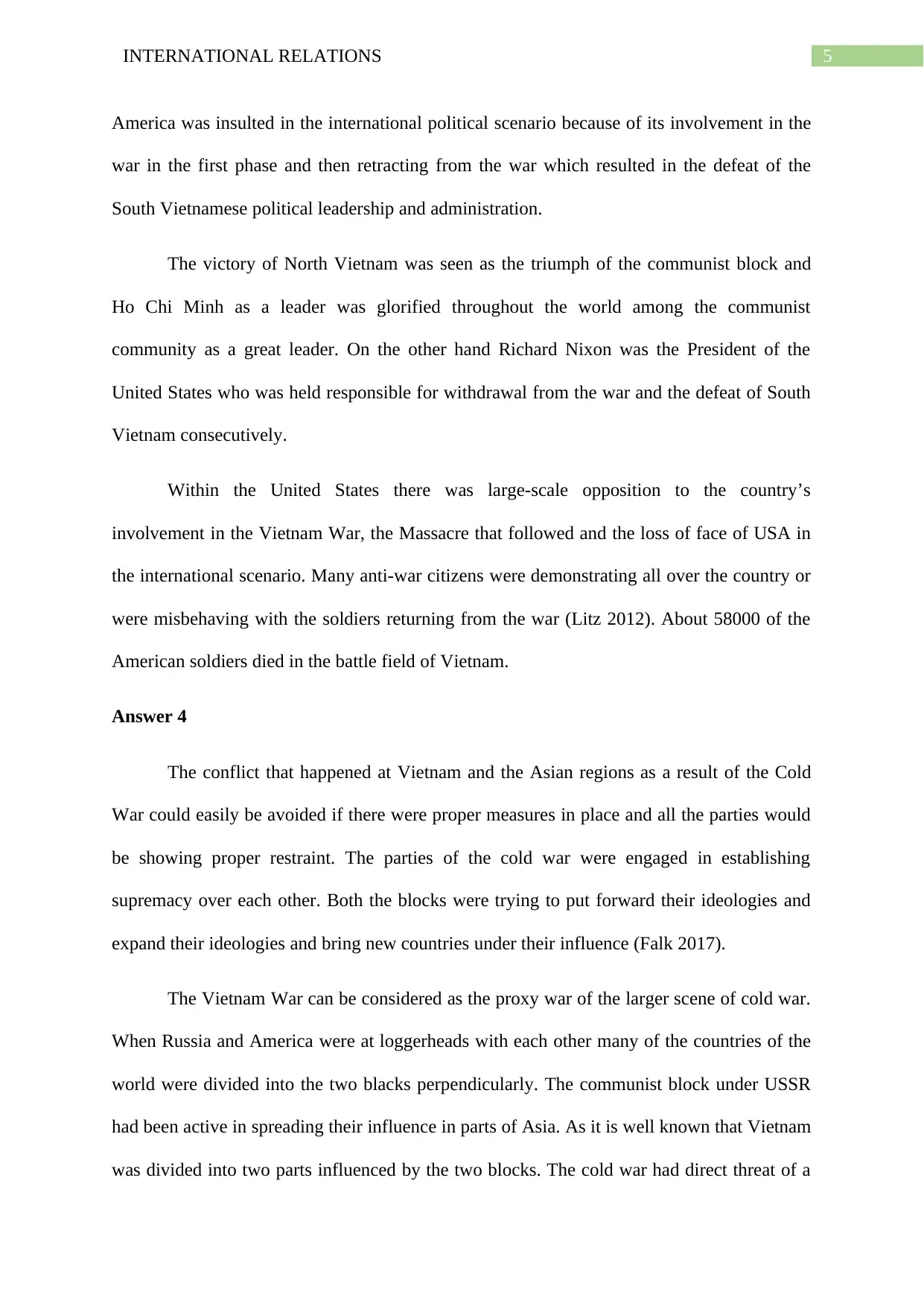
5INTERNATIONAL RELATIONS
America was insulted in the international political scenario because of its involvement in the
war in the first phase and then retracting from the war which resulted in the defeat of the
South Vietnamese political leadership and administration.
The victory of North Vietnam was seen as the triumph of the communist block and
Ho Chi Minh as a leader was glorified throughout the world among the communist
community as a great leader. On the other hand Richard Nixon was the President of the
United States who was held responsible for withdrawal from the war and the defeat of South
Vietnam consecutively.
Within the United States there was large-scale opposition to the country’s
involvement in the Vietnam War, the Massacre that followed and the loss of face of USA in
the international scenario. Many anti-war citizens were demonstrating all over the country or
were misbehaving with the soldiers returning from the war (Litz 2012). About 58000 of the
American soldiers died in the battle field of Vietnam.
Answer 4
The conflict that happened at Vietnam and the Asian regions as a result of the Cold
War could easily be avoided if there were proper measures in place and all the parties would
be showing proper restraint. The parties of the cold war were engaged in establishing
supremacy over each other. Both the blocks were trying to put forward their ideologies and
expand their ideologies and bring new countries under their influence (Falk 2017).
The Vietnam War can be considered as the proxy war of the larger scene of cold war.
When Russia and America were at loggerheads with each other many of the countries of the
world were divided into the two blacks perpendicularly. The communist block under USSR
had been active in spreading their influence in parts of Asia. As it is well known that Vietnam
was divided into two parts influenced by the two blocks. The cold war had direct threat of a
America was insulted in the international political scenario because of its involvement in the
war in the first phase and then retracting from the war which resulted in the defeat of the
South Vietnamese political leadership and administration.
The victory of North Vietnam was seen as the triumph of the communist block and
Ho Chi Minh as a leader was glorified throughout the world among the communist
community as a great leader. On the other hand Richard Nixon was the President of the
United States who was held responsible for withdrawal from the war and the defeat of South
Vietnam consecutively.
Within the United States there was large-scale opposition to the country’s
involvement in the Vietnam War, the Massacre that followed and the loss of face of USA in
the international scenario. Many anti-war citizens were demonstrating all over the country or
were misbehaving with the soldiers returning from the war (Litz 2012). About 58000 of the
American soldiers died in the battle field of Vietnam.
Answer 4
The conflict that happened at Vietnam and the Asian regions as a result of the Cold
War could easily be avoided if there were proper measures in place and all the parties would
be showing proper restraint. The parties of the cold war were engaged in establishing
supremacy over each other. Both the blocks were trying to put forward their ideologies and
expand their ideologies and bring new countries under their influence (Falk 2017).
The Vietnam War can be considered as the proxy war of the larger scene of cold war.
When Russia and America were at loggerheads with each other many of the countries of the
world were divided into the two blacks perpendicularly. The communist block under USSR
had been active in spreading their influence in parts of Asia. As it is well known that Vietnam
was divided into two parts influenced by the two blocks. The cold war had direct threat of a

6INTERNATIONAL RELATIONS
full-fledged nuclear war. The Cuban Missile crisis has been one of the boiling points of the
cold war. This incident has convinced both the sides that there was an actual threat of a
nuclear war.
However unlike Cuban Missile crisis there were many other regions around the globe
where both the parties were surrounding two conflicting parties to exert their influence. In
Vietnam, the case was similar and the North Vietnam with its communist ideology was at war
with the south which was supported by America (Short 2014). The war between North and
South Vietnam caused casualties which ran into thousands and lakhs. Only from the USA
army there were more than 58000 casualty. This huge mass massacre could be avoided if
proper action was taken and both the sides acted more responsibly.
In a simulated situation when there was a tension building up among the two parties it
is ideal that they try to resort the differences out in a peaceful manner through mutual
dialogues. USA should have stayed out of the Vietnamese scene, and USSR should have
allowed Vietnam grow politically as an independent entity. When there was a chance of
conflict emerging both the powers should have come on the tables to have a dialogue and
resolve the conflict along with the Vietnamese political entities. The communist political
party in Vietnam could be brought to table and a peace proposal could be given (Duiker
2018).
These are some of the ways in which the conflict in Vietnam could be resolved
peacefully without intervention of foreign powers. The armed conflict was a result of
unnecessary power play of foreign powers in the Vietnamese soil. In a simulated situation
when there was a tension building up among the two parties it is best that they try to help the
differences out in a peaceful manner through mutual dialogues. When there was a chance of
full-fledged nuclear war. The Cuban Missile crisis has been one of the boiling points of the
cold war. This incident has convinced both the sides that there was an actual threat of a
nuclear war.
However unlike Cuban Missile crisis there were many other regions around the globe
where both the parties were surrounding two conflicting parties to exert their influence. In
Vietnam, the case was similar and the North Vietnam with its communist ideology was at war
with the south which was supported by America (Short 2014). The war between North and
South Vietnam caused casualties which ran into thousands and lakhs. Only from the USA
army there were more than 58000 casualty. This huge mass massacre could be avoided if
proper action was taken and both the sides acted more responsibly.
In a simulated situation when there was a tension building up among the two parties it
is ideal that they try to resort the differences out in a peaceful manner through mutual
dialogues. USA should have stayed out of the Vietnamese scene, and USSR should have
allowed Vietnam grow politically as an independent entity. When there was a chance of
conflict emerging both the powers should have come on the tables to have a dialogue and
resolve the conflict along with the Vietnamese political entities. The communist political
party in Vietnam could be brought to table and a peace proposal could be given (Duiker
2018).
These are some of the ways in which the conflict in Vietnam could be resolved
peacefully without intervention of foreign powers. The armed conflict was a result of
unnecessary power play of foreign powers in the Vietnamese soil. In a simulated situation
when there was a tension building up among the two parties it is best that they try to help the
differences out in a peaceful manner through mutual dialogues. When there was a chance of
Paraphrase This Document
Need a fresh take? Get an instant paraphrase of this document with our AI Paraphraser
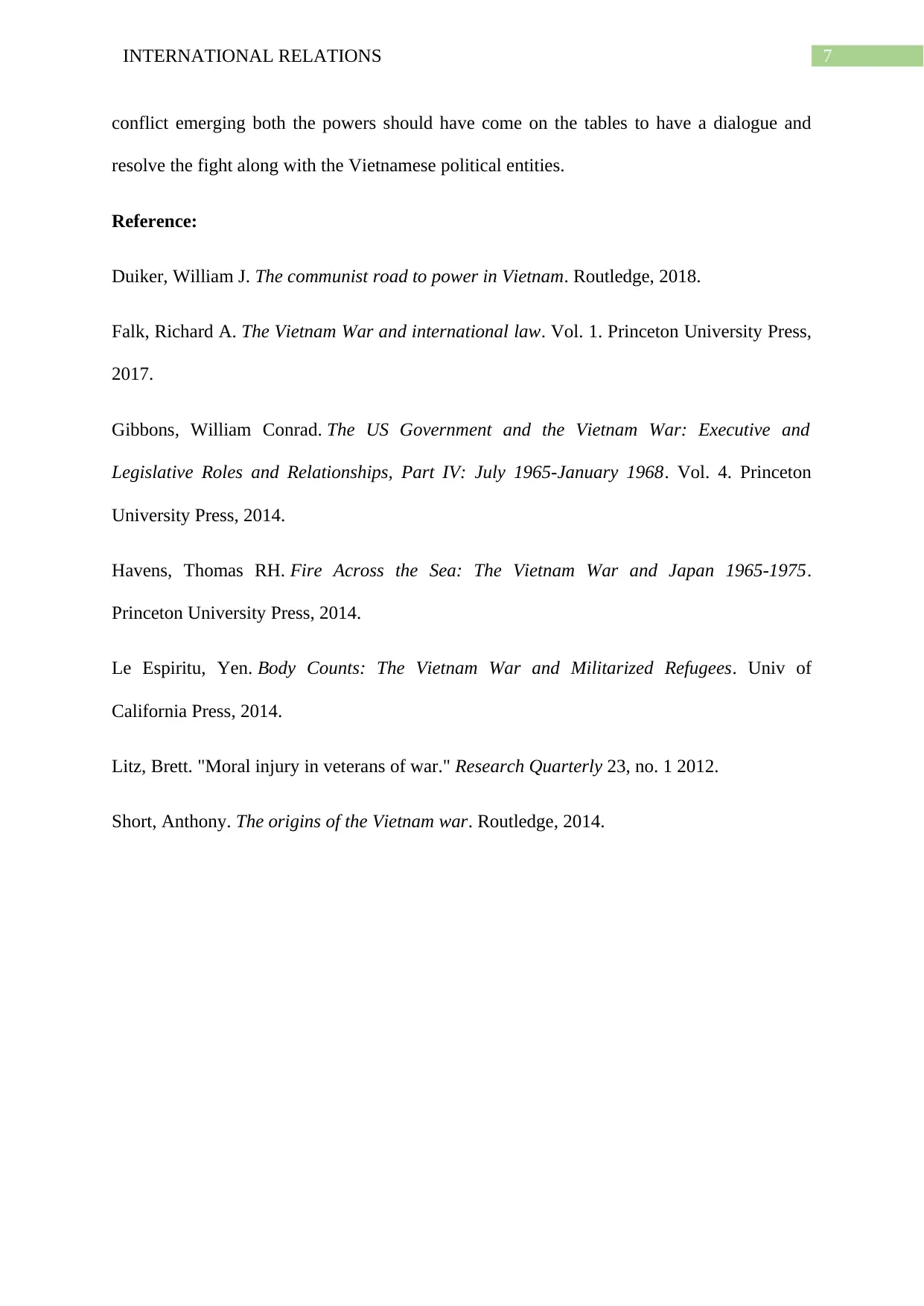
7INTERNATIONAL RELATIONS
conflict emerging both the powers should have come on the tables to have a dialogue and
resolve the fight along with the Vietnamese political entities.
Reference:
Duiker, William J. The communist road to power in Vietnam. Routledge, 2018.
Falk, Richard A. The Vietnam War and international law. Vol. 1. Princeton University Press,
2017.
Gibbons, William Conrad. The US Government and the Vietnam War: Executive and
Legislative Roles and Relationships, Part IV: July 1965-January 1968. Vol. 4. Princeton
University Press, 2014.
Havens, Thomas RH. Fire Across the Sea: The Vietnam War and Japan 1965-1975.
Princeton University Press, 2014.
Le Espiritu, Yen. Body Counts: The Vietnam War and Militarized Refugees. Univ of
California Press, 2014.
Litz, Brett. "Moral injury in veterans of war." Research Quarterly 23, no. 1 2012.
Short, Anthony. The origins of the Vietnam war. Routledge, 2014.
conflict emerging both the powers should have come on the tables to have a dialogue and
resolve the fight along with the Vietnamese political entities.
Reference:
Duiker, William J. The communist road to power in Vietnam. Routledge, 2018.
Falk, Richard A. The Vietnam War and international law. Vol. 1. Princeton University Press,
2017.
Gibbons, William Conrad. The US Government and the Vietnam War: Executive and
Legislative Roles and Relationships, Part IV: July 1965-January 1968. Vol. 4. Princeton
University Press, 2014.
Havens, Thomas RH. Fire Across the Sea: The Vietnam War and Japan 1965-1975.
Princeton University Press, 2014.
Le Espiritu, Yen. Body Counts: The Vietnam War and Militarized Refugees. Univ of
California Press, 2014.
Litz, Brett. "Moral injury in veterans of war." Research Quarterly 23, no. 1 2012.
Short, Anthony. The origins of the Vietnam war. Routledge, 2014.
1 out of 8
Related Documents
Your All-in-One AI-Powered Toolkit for Academic Success.
+13062052269
info@desklib.com
Available 24*7 on WhatsApp / Email
![[object Object]](/_next/static/media/star-bottom.7253800d.svg)
Unlock your academic potential
© 2024 | Zucol Services PVT LTD | All rights reserved.




